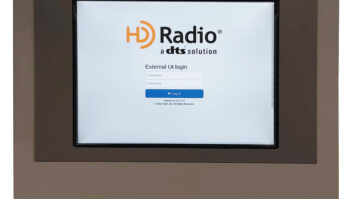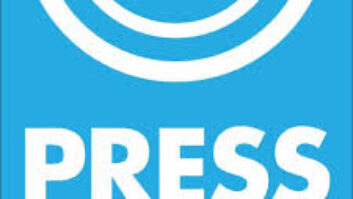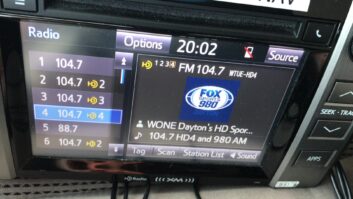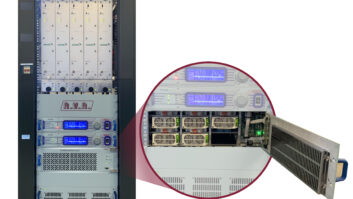LAS VEGAS Operating a group of radio stations spread over a large geographic area can present challenges unlike any others. Nevada Public Radio does just this in a sprawling area covering south and central Nevada and southwestern Utah.
Nevada Public Radio is the licensee of six radio stations. All are full-service FMs and the extended spacing between the locations prevents the use of traditional STL links in all but the two local stations in Las Vegas.
Because of this geographic challenge, Nevada Public Radio Director of Broadcast Operations Phil Burger has used satellite links to feed the four outlying stations with analog programming content. Fig. 1 shows the vast geography that Nevada Public Radio serves.

Nevada Public Radio Coverage “The installation of satellite receivers at the remote stations took about a year, with most of the work done in 2002,” said Burger. “Bill Garban of Las Vegas installed the [3.8 meter] dishes. Our contract engineer, Warren Brown, handled the audio. Other than the fact that these are remote, mountaintop sites, it was not that difficult.”
The prospect of HD Radio offered some opportunities to provide additional programming service to the distant stations. In Las Vegas, KNPR is an all-news/talk format. KCNV is an all-classical music station. The distant stations have broadcast the KNPR format but it has not been practical to develop additional station licenses to rebroadcast the KCNV format in the distant cities due to the smaller populations.
“We were among the first in the nation to go IBOC,” said Burger, adding that KNPR was the original Las Vegas test station for Lucent Digital Radio’s technology.
KCNV started IBOC transmission in December 2004. At 650 watts TPO it was relatively easy to convert the Nautel FM2 transmitter to IBOC, he said. All six stations in the Nevada Public Radio group are running an FM analog and an HD Radio signal. Five run the identical FM+ HD signal and KCNV transmits a separate FM+ HD stream. Most of the HD conversions were accomplished by the fall of 2007.
The multiple program capability of HD Radio was the answer to providing alternate programming to those other audiences. The problem was that there were no STL links possible, and no telephone, T1, any wired services or even cellular service available at most of the outlying transmitter sites. It seemed satellite was the only way to distribute the HD programming, just as it was in the case of Nevada Public Radio’s analog service.
Looking at the data bandwidth requirements of the combined HD programming Ethernet link, Fig. 2 shows the large data bursts followed by extended periods of no data being sent. Analysis of the HD stream with data packets up to 19 kilobits shows that a 1.5 megabit link is ideal to allow the bursts of data.
This much data space on satellite is quite expensive. Using a narrower data channel can be problematic because maintaining the integrity of the data stream is important in HD transport. A 99.999 percent data integrity level still equates to a 1-1/2 second audio dropout every two days.
Thus, 99.99 percent is one dropout every four hours. Lowering the data channel bandwidth requires re-formatting the HD data stream itself to smooth out the bursts. This leads directly to the Nautel Reliable HD Transport system.

IBiquity E2X Data Bursts Fig. 3 shows the Nautel RHDT stream compared to the standard E2X HD stream. RHDT sends the data packets in a more uniform manner with more timing packets added.
Instead of requiring a peak bandwidth of 1.5 megabits, the same HD information can be sent in a consistent 150 kilobits-per-second stream. Even allowing for resending data and more frequent clock packets, a 200 kHz satellite channel is quite adequate.
Resending lost data is not a burden with this scheme and Nevada Public Radio sends a consistent 195 kbps stream on its 200 kHz segment. With the reduced bandwidth multiple HD streams could be sent on the same link allowing shared uplinks for multiple stations.
In using Nautel Exporters and Exciters, implementation of RHDT was easy for Nevada Public Radio since the data stream balancing process occurs right in the Nautel HD Radio Exporters and Exciters. Users of other brands of HD systems can insert Nautel RHDT Units at each end of the path to gain the benefits of the system.
The balancing process allows a time buffer to be set so that packet retransmissions can occur before the programming goes to air. In the case of the distant sites, there is no channel for resend requests so the programming just goes to air.
At the studio site a Radyne satellite receiver is able to monitor the 200 kHz satellite segment, and, coupled with an RHDT unit, make resend requests based on the integrity of that path. Any packets lost in the uplink or downlink can thus be resent. In practice, KNPR has found that the path only averaged about one dropped packet per week on the Ku band system.

In this and other installations, users report that the more uniform flow of data with RHDT has resulted in fewer dropped packets and resulting program interruptions than with the standard iBiquity Digital data format.
The characteristic clear weather of the Nevada region is not prone to interruptions of the satellite signal except for occasional thunderstorms in the summer and snow storms in the winter. These interruptions occur for analog satellite links as well as data links so the service reliability of HD compared to FM analog does not change for the distant stations. KNPR plans to winterize the satellite dishes at the remote locations to further minimize downtime caused by weather.
In a unique decision, KNPR opted to use satellite HD delivery for its local Las Vegas signal. This allowed the public broadcaster to retain its present STL analog link for the local stations.
The delay differential between STL and satellite is matched using the exporter delay and delay in the Omnia audio processor with different values for each to make up the quarter second difference added by the satellite path.
Now KNPR’s local audience as well as listeners in the other cities can select from additional program choices:
- • HD1 is the regular KNPR news/talk format
- • HD2 duplicates the KCNV classical format. This extends the coverage of the format in Las Vegas since KCNV has much lower transmitter power. In addition the format is now available in the distant cities.
- • HD3 presents an alternative news/talk format as counter-programming to the main channel. This represents an added program choice in all the areas served.
KNPR is planning to drop the analog satellite signal eventually. The RHDT system allows for extracting the main HD1 channel to present an analog feed to the exciters. The HD satellite feed will therefore serve both analog and HD feed functions.
Talking about the installation and the RHDT system, Burger said, “I think early on the software engineers at Nautel realized that in the real world of broadcast radio the studio/transmitter link can vary from station to station. They wanted to make the process of data delivery to transmitters easier — and they did it.”

Rebalanced HD Stream Using RHDT “Nautel’s RHDT protocol is the key to making this system work,” he said. “It creates a more reliable data stream that uses less bandwidth. Without it, we would have to lease three times the satellite bandwidth, at three times the cost. RHDT keeps the bandwidth requirements low and provides reliable data transport. That’s the only way we can afford to provide HD signals to remote transmitters.”
Adding HD meant splitting the satellite signal for the FM audio and for the Radyne DMD20 receiver. “Then it was a matter of replacing the old analog transmitters with the new Nautel HD transmitters and plugging everything in,” said Burger.
The work on KNPR, KTPH, KLNR and KWPR was completed with CPB digital conversion grants. Those four stations combined for a project total of $450,000, with approximately 80 percent paid by CPB.
KSGU was built as a new station in 2005 and only required an Exgine upgrade on the Nautel exciter and the Radyne receiver.
In addition to their main digital stream, all six Nevada Public Radio stations are also transmitting two multicast signals each.
Nevada Public Radio is successfully using satellite as a delivery mechanism for multiple HD program services to far distant transmitter locations. The Nautel Reliable HD Transport system makes the feeds more reliable at a lower cost with more savings in the future as the analog satellite link is dropped.












